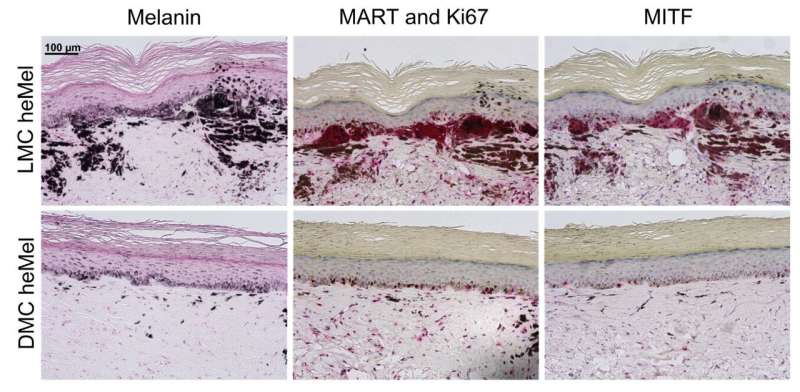Histologic characterization of representative orthotopic skin and resulting tumors, including MC and proliferation markers MITF (red), Ki67 (dark brown, nuclear)/MART (red), and Fontana Masson (melanin, dark brown). Images taken at ×20 magnification. Scale bar, 100 μm. a.u., arbitrary units. Credit: Science Advances (2022). DOI: 10.1126/sciadv.abn4007
People with light skin tones are far more likely to develop melanoma skin cancer than people with dark skin tones. This large disparity results from far more than can be explained by the UV protective effects of melanin pigment, and results in large part from the melanin precursor DOPA, and its ability to inhibit CHRM1, according to new research from the Perelman School of Medicine at the University of Pennsylvania.
Additionally, the researchers found that inhibiting FOXM1, a transcription factor downstream of CHRM1, also inhibits melanoma. These findings highlight two new potential therapeutic targets for melanoma, and show that it may be possible to repurpose the main medicine for Parkinson's disease, levodopa, to inhibit melanoma. The study is published in Science Advances.
"For decades, dermatologists and melanoma researchers thought that the particular susceptibility to melanoma in lightly pigmented skin resulted from a relative lack of protection against UV damage from the sun. This work shows that the biology is far more complex" said Todd Ridky, MD, Ph.D., an associate professor of Dermatology at Penn and senior author of the study. "Not only does this research offer significant potential for new melanoma therapies, it also markedly expands the classical paradigm of melanocyte function and melanoma pathobiology."
Every year, there are roughly 100,000 people are diagnosed with melanoma in the United States, according to the National Cancer Institute. Melanoma is also the type of skin cancer most likely to spread to other parts of the body and, on a case by case basis, the most likely to be deadly.
For years, researchers have linked melanin and skin pigmentation to the likelihood of developing melanoma. Melanoma risk is at least 30 times higher in individuals whose skin is more lightly pigmented compared to peers whose skin is darkly pigmented.
Scientists at Penn began their investigation by studying the melanocytes, melanin producing cells, from light-pigmented skin and dark-pigmented human skin. They found that melanocytes from lightly pigmented skin proliferate much more quickly in the lab compared to melanocytes from darkly pigmented skin.
Importantly, these proliferation differences occur inside dark laboratory incubators where there is no exposure to sun or UV. They hypothesized that this increased proliferation helps explain why the light skin melanocytes are more likely to transform into melanoma than the relatively slowly proliferating dark melanocytes.
Next, the investigators engineered both the light and dark melanocytes to express the same set of mutant oncoproteins responsible for melanoma in people. The light cells turned into melanomas, while the dark ones did not, showing that the darker cells naturally have a significant ability to resistant cancer that is independent of sunlight.
Miriam Doepner, senior graduate student in Ridky's lab and lead author on the study, found that darkly-pigmented melanocytes contain more of the chemical dihydroxyphenylalanine (DOPA) than lightly-pigmented melanocytes, and that this was the critical differential factor between the light and dark cells. Doepner went on to determine that the protective effect of DOPA results from its previously unrecognized ability to block signaling from a receptor called CHRM1, which is normally activated by acetylcholine.
"This was very exciting, as DOPA was not previously known to have anything to do with CHRM1, and because DOPA is already an FDA approved agent for Parkinson's disease," said Doepner. The researchers then looked downstream of CHRM1 in melanocytes and observed that the FOXM1 protein was also inhibited by DOPA. They collaborated with investigators at the University of Illinois and determined that their novel FOXM1 inhibitor compound was effective at inhibiting melanoma in mice.
"CHRM1 and FOXM1 are not currently targeted by any available melanoma therapeutics, but through this work, we discovered an important role for both of them. Future work will be needed to identify whether there is a safe and effective way to pharmacologically target then in people," said Ridky. However, since a formulation containing DOPA is already FDA approved to treat Parkinson's Disease, clinical trials testing the utility of repurposing it for melanoma could be much faster than for a brand new anti-cancer agent.
More information: Miriam Doepner et al, Endogenous DOPA inhibits melanoma through suppression of CHRM1 signaling, Science Advances (2022). DOI: 10.1126/sciadv.abn4007
Journal information: Science Advances























